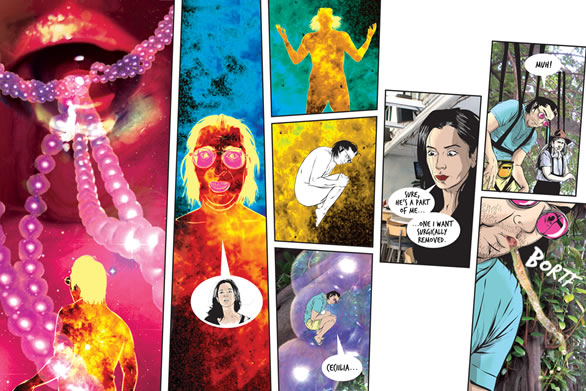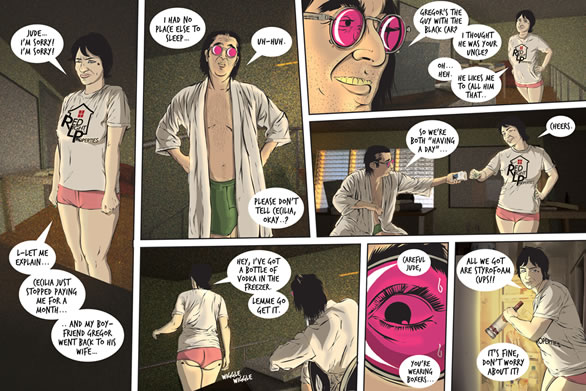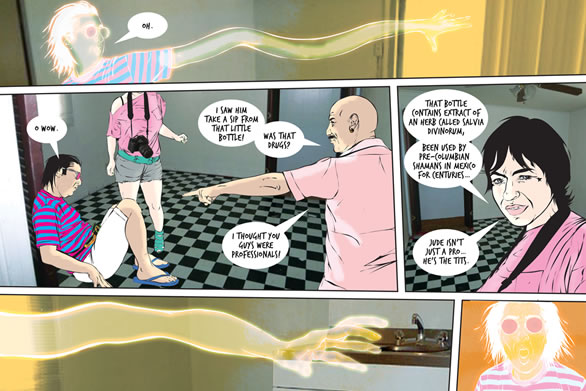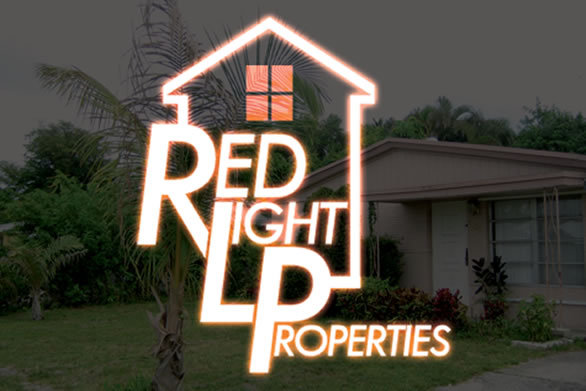Today marks the release of a brand new episode of Red Light Properties, Dan Goldman’s psychedelic horror webcomic serialized on Tor.com. Mixing the supernatural realm with an all-too-familiar world of marriage breakdowns, financial meltdowns and everyday horrors, the strip is more impressive work from the man behind Shooting War and 08: A Graphic Diary Of The Campaign Trail. I spoke to Goldman about the series.
For newcomers, how would you describe Red Light Properties?
Red Light Properties is the first book in a series of what I’m calling “tropical horror” graphic novels. It tells the story of a small Miami real estate firm that exorcizes and sells “previously-haunted” homes to victims of the mortgage crisis. The firm’s owners, Jude Tobin and his soon-to-be-ex-wife Cecilia, struggle to keep their own building’s mortgage paid, the electricity on and their young son provided for while the remains of the real estate market smolders around them.
And while the company’s exorcisms rely on Jude’s frequent intake of “entheogenic substances” to enter the spirit realm to communicate with the dead, it’s that same hallucinogen intake that’s pushing him further away from his marriage, his kid, society at large… and the world of the living.

One of the things I love about the strip is the slow build; at first, it reads as if you’ve created a world with a great supernatural concept that’s almost incidental to the story you want to tell, which is a very human, very honest one, with Jude and Cecilia’s mutual fucked-upness acting as the black hole or center of gravity, depending on your kindness, that keeps everyone else around – and then, slowly, something bigger seems to be emerging with the latest chapters – How much of that was intentional from the get-go? Was it important for you to ground the reader in the world and the dynamic of the characters before things went to hell?
Yes, entirely intentional. There’s a formula to scriptwriting that’s overly informed by TV/Hollywood, where the scenario begins with shit constantly hitting the fan well before you’ve formed any bond with the people caught in the crossfire. I suppose the slow build is my pushing against that, because stories told the right way round are the ones that really stick with me.
I purposely wanted the reader to spend time in Jude/Cecilia/Zoya/Turi/Rhoda’s shabby shoes and soak up their personal and professional desperation so that as the heat slowly gets turned up, it’s happening to these poor schlubs you’re already invested in emotionally.
There’s a real marriage of magic and the mundane in RLP – A feeling that magic is *real* because of the matter-of-fact way that people deal with it, as opposed to the more sensational “Oh my god, what was that?” of other supernatural/magical realist stories. In a way, it reminds me of Jonathan Carroll – Where did that come from? What are your influences in the worldbuilding of Red Light Properties?
It’s really a matter of telling the story from characters’ perspectives, where the spirit world is real and something they unfortunately have to co-exist with; the angle they see Miami (and the world) from is different… and when their reality brushes up against “ours”, that where the meat of a story lies. That’s something we’re going to be seeing a lot more of as the series goes forward: how something fantastical that they take for granted reconciles itself with a science-based framework… or even worse, a political one. Or worse than that, a religious one.
I’m a big admirer of Jonathan Carroll’s style, but there are certainly heavier influences running the gamut from Philip Roth to Terence McKenna, Brendan McCarthy, Larry David, Vince Gilligan… but the biggest influence has to be the city of Miami, where I grew up. There’s a particular vibe there, some kind of sun-bleached darkness is the best way I can describe it, that always fascinated me, had me peeking into dark corners and buying historical books on the city’s foundation. It’s all going to start pouring out of these panels eventually.

The art is very individual, mixing photography and lineart – Why’d you choose to mix the two (The photographic backgrounds really make the more psychadelic sequences pop, by comparison)? What’s the process for putting the pages together?
The digital-collage/comic art style I’m using with this series a continuation of my work from my 2007 graphic novel Shooting War and my webcomic Kelly before that… but for this series, I’ve added in the use of 3D models as well. Using a architectural rendering engine, I’m able to design virtual sets and change the lighting according to the time of day. I’m constantly frustrated by my art, and thus looking for new ways to do what I do better and with less hair-pulling and crying.
My work is created entirely digitally, drawn with electronic pens on touchscreens. I use both a Wacom Cintiq and an Axiotron Modbook; they’re both invaluable tools… I couldn’t do those eight page chapters without them.
I always begin with full-script; that’s the place the ideas are committed, and I get really formal and anal even though I’m writing just for myself at the moment. From there, all my chicken-scratch layouts are done in Sketchbook Pro, and from there I shoot actors for anatomy and position and performance until I’m satified that I’m capturing the tone of what I’ve put down in my script. I manage all my character reference photography in Adobe Lightroom, drawn all my line art in Adobe Illustrator, model/render background environments in Maya.
Once all the elements are created, everything is composited into a Photoshop PSD, where I color, assemble, re-light, letter and export the final comic panels for use in print or online. If I’m compiling a book, I’ll create printer-ready files in InDesign.
How did RLP end up with Tor? Was there a print deal that was retrofitted into an online serialization, did they approach you, were you looking for a home for RLP and they seemed like a good fit?
Not at all. I wrote the first draft of RLP (and some of the series’ subsequent volumes) nearly nine years ago; this was always a point I was working towards, being able to tell the story of this little office on Miami Beach, both in terms of my abilities and my career. After doing 3 politically-slanted graphic novels since 2004, I felt ready to finally take this one on for real.
Early last year, I’d done a very well-received short comic called Yes We Will about the end of Obama’s first term coinciding with the end of the Mayan calendar in 2012. I had a good experience working with them, and since they were one of the few places I was able to get a page rate on a webcomic, I kept asking their editor about when they’d be interested in doing some long-form original comics. One day, he asked me what I had and he flipped out over what I came back to him with, since it had been this fully-formed world I’d been tinkering with for years already.
Carrying on from that a bit – Or maybe contradicting it entirely – how much of RLP‘s supernatural aspect came from trying to fit into the idea of “a Tor book”? It seems an ideal fit for the publisher, but was that a happy accident?
The story’s evolved as our own American real estate meltdown dovetailed nicely into the scenery of this story that had been my pet project since 2001… but I certainly didn’t tailor it for Tor or anyone else. What you’re reading on Tor has seen practically zero edits from them (typos notwithstanding); I wrote the script exactly how I wanted to draw it, ghosts and drugs and vibrators and fart jokes and all… and that’s how they bought it. The prospect of it being the first of a series seemed to pique their interest as well, though I’ve not yet determined where “Mala Fama”, the series’ second volume, will be published online yet.
The rewriting process on this book has been unique for me; I’ve written the entire book about seven times, and after the third rewrite, I’d completely stopped reediting previous versions. Instead, I’ve started at page one and written down through page 200… and whatever I’d forgotten wasn’t important anyways; the story tightened with each draft. The version I’ve drawn is draft seven, and now I’m doing minute dialogue tweaks as I letter word balloons on the finished pages.

Has there been any pushback or fallout about the drug use in the story?
Nope; I’m getting a lot of high-fives though.
So where is the story going? Both literally and metaphorically… Is there a definite ending, or could the series continue indefinitely? And within the story itself, will there be answers to some of the questions that always seem as much part of the world’s status quo as potential dangling plot?
There is a definite end for Red Light Properties, but the series is flexible enough that I weave more stories into the tapestry as we take Jude and company towards that endpoint. I’ve currently got seven books on my list, with the first three novels being entirely written and the fourth knitting itself together while I try to ignore it.
I’m really viewing the entire series as a single story; there will certainly be questions answered and new ones raised, but some of the heavier things I’m only hinting at now will definitely come to the forefront and be slowly knit together into an emerging structure. The next volumes of the series will deal with Jude’s initiation into Santería, the true role of Rory Partch’s SFAP organization, and alternate ideologies involved in urban planning. I’ve been interested in metaphysical phenomena all my life, and this series is going to keep me working and happy for a quite a while longer before I hit THE END.

For those yet to experience Red Light Properties, start here. You can find out more about Dan Goldman at his website, and he invites you all to stalk him on Twitter at @dddangoldmannn. Yes, that’s three Ds and three Ns.

